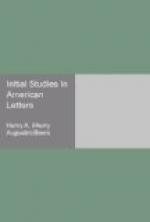Hawthorne was no transcendentalist. He dwelt much in a world of ideas, and he sometimes doubted whether the tree on the bank or its image in the stream were the more real. But this had little in common with the philosophical idealism of his neighbors. He reverenced Emerson, and he held kindly intercourse—albeit a silent man and easily bored—with Thoreau and Ellery Channing, and even with Margaret Fuller. But his sharp eyes saw whatever was whimsical or weak in the apostles of the new faith. He had little enthusiasm for causes or reforms, and among so many Abolitionists he remained a Democrat, and even wrote a campaign life of his friend Pierce.
The village of Concord has perhaps done more for American literature than the city of New York. Certainly there are few places where associations, both patriotic and poetic, cluster so thickly. At one side of the grounds of the Old Manse—which has the river at its back—runs down a shaded lane to the Concord monument and the figure of the Minute Man and the successor of “the rude bridge that arched the flood.” Scarce two miles away, among the woods, is little Walden—“God’s drop.” The men who made Concord famous are asleep in Sleepy Hollow, yet still their memory prevails to draw seekers after truth to the Concord Summer School of Philosophy, which met annually, a few years since, to reason high of “God, Freedom, and Immortality,” next door to the “Wayside,” and under the hill on whose ridge Hawthorne wore a path as he paced up and down beneath the hemlocks.
1. Ralph Waldo Emerson. Nature. The American Scholar. Literary Ethics. The Transcendentalism. The Over-soul. Address before the Cambridge Divinity School. English Traits. Representative Men. Poems.
2. Henry David Thoreau. Excursions. Walden. A Week on the Concord and Merrimac Rivers. Cape Cod. The Maine Woods.
3. Nathaniel Hawthorne. Mosses from an Old Manse. The Scarlet Letter. The House of the Seven Gables. The Blithedale Romance. The Marble Faun. Our Old Home.




